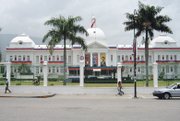Quick Facts: Haiti
bull; The Republic of Haiti covers 10,714 square miles of the island of Hispanola, which Haiti shares with the Dominican Republic. The country is approximately the size of Maryland with a total population of 8.5 million. Of those, 2 million reside in the capital, Port-au-Prince.
bull; Haiti has been an independent republic since 1804 and is the world’s oldest black republic and the second-oldest republic in the Western Hemisphere after the United States.
bull; French and Creole are the official languages of Haiti, although Creole is much more predominantly spoken by Haitians. English is rapidly increasing in usage within the business community.
bull; The entire country’s gross domestic product is $4.8 billion. Of that, 27 percent represents agriculture, 14 percent represents industry, 52 percent represents services, and 7 percent represents indirect and import taxes.
bull; Although Haiti won its independence from France more than 200 years ago, its current constitution is a mere 20 years old. The country’s political history has been chaotic. For nearly 30 years until 1987, the country was ruled under the dictatorship of Francoise “Papa Doc” Duvalier and his son, Jean-Claude “Baby Doc” Duvalier. Haiti’s current president, Rene Preval, has twice succeeded former president Jean-Betrande Aristide, who was overthrown in a 1991 military coup during his first presidency and resigned in 2004 during his second presidency, in which he was elected following an election scandal.
bull; The United Nations has stationed a multilateral interim force in Haiti made up of U.N. officers from the United States, Canada, France and Chile since 2004.
bull; According to the U.S. State Department, Haiti is one of the leastdeveloped countries in the Western Hemisphere and one of the poorest in the world.
bull; After the 1991 coup, the country fell into sharp economic decline. A U.N.-issued embargo in 1994 limited the import of goods into Haiti to humanitarian supplies such as food and medicine.
bull; At its height in the 1980s, the country’s assembly sector employed 100,000 people. Employment fell below 17,000 during the embargo. Today, assembly employment has climbed to 18,500.
bull; The export of apparel and household goods from Haiti to the United States grew by more than 100 percent from $218 in 2002 to $450 million in 2006, according to the U.S. Census statistics on foreign trade.
bull; Haiti’s parliament passed a law in 2002 recognizing the importance of direct foreign investment in the country’s economic recovery. The law makes it a crime to discriminate against foreign investors. According to the U.S. State Department, “American firms enjoy free transfer of interest, dividends, profits and other revenues stemming from their investments and are guaranteed just compensation paid in advance of expropriation, as well as compensation in case of damages or losses caused by war, revolution or insurrection.”
bull; In December 2006, the United States passed the Hemisphere Opportunity Through Partnership Encouragement Act (HOPE), which provides trade preferences for textile and apparel products made in Haiti and exported to the United States.
bull; The country’s capital—and employment center—is two hours by plane from Miami. Several airlines run multiple daily flights from Miami and Fort Lauderdale, Fla., to Port-au-Prince. There is also a daily direct flight from New York to Port-au- Prince, and discount airline carrier Spirit Airlines recently began scheduling flights to Haiti.






















